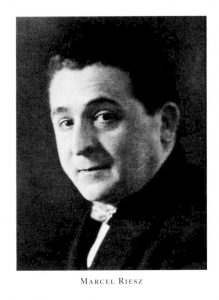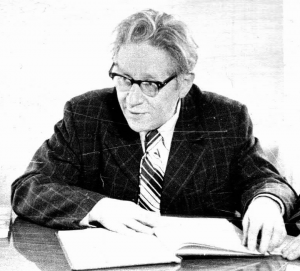
This post is about Riesz energy problems, a subject that I like to explore with Edward B. Saff (Vanderbilt University, USA) and Robert S. Womersley (UNSW Sydney, Australia).
Riesz kernel. For $-2<s<d$, the Riesz $s$-kernel in $\mathbb{R}^d$ is $$
K_s:=\begin{cases}
\displaystyle\frac{1}{s\left|\cdot\right|^{s}} & \text{if } s\neq0\\[1em]
\displaystyle-\log\left|\cdot\right| & \text{if } s=0
\end{cases}.
$$ We recover the Coulomb or Newton kernel when $s=d-2$. This definition of the $s$-kernel allows to pass from $K_s$ to $K_0$ by removing the $1/s$ singularity at $s=0$, namely, for $x\neq0$, $$-\log|x|=\lim_{\underset{s\neq0}{s\to0}}\frac{|x|^{-s}-1}{s-0}=\lim_{\underset {s\neq0}{s\to0}}\Bigr(\frac{1}{s|x|^s}-\frac{1}{s}\Bigr).$$
Riesz energy. For $-2<s<d$, the Riesz energy of a probability measure $\mu$ on $\mathbb{R}^d$ is $$
\mathrm{I}_s(\mu):=\iint K_s(x-y)\mathrm{d}\mu(x)\mathrm{d}\mu(y)
=\int(K_s*\mu)\mathrm{d}\mu.
$$ The Riesz energy is strictly convex and lower semi-continuous for the weak convergence of probability measures with respect to continuous and bounded test functions. This convexity is related to the Bochner positivity of $K_s$, which is a nice observation from harmonic analysis.
Equilibrium measure. The equilibrium measure on a ball $B_R:=\{x\in\mathbb{R}^d:|x|\leq R\}$ is
$$
\mu_{\mathrm{eq}}
=\arg\min_{\substack{\mu\\\mathrm{supp}(\mu)\subset B_R}}\mathrm{I}_s(\mu).
$$
Riesz original problem (1938). Equilibrium measure on $B_R$ when $d\geq2$ :
$$
\mu_{\mathrm{eq}}
=
\begin{cases}
\sigma_R & \text{if $-2<s\leq d-2$}\\[1em]
\displaystyle\frac{\Gamma(1+\frac{s}{2})}{R^s\pi^{\frac{d}{2}}\Gamma(1+\frac{s-d}{2})}
\frac{\mathbf{1}_{B_R}}{(R^2-|x|^2)^{\frac{d-s}{2}}}\mathrm{d}x &
\text{if $0\leq d-2<s<d$}
\end{cases}
$$ where $\sigma_R$ is the uniform distribution on the sphere $\{x\in\mathbb{R}^d:|x|=R\}$ of radius $R$.
The proof relies on the following integral formula for the variational characterization : $$
\int_{|y|\leq R}
\frac{|x-y|^{-s}}{(R^2-|y|^2)^{\frac{d-s}{2}}}\mathrm{d} y
=\frac{\pi^{\frac{d}{2}+1}}{\Gamma(\frac{d}{2})\sin(\frac{\pi}{2}(d-s))},\,\quad
x\in B_R
$$ The Riesz proof of this integral formula involves in turn a Kelvin transform and a reduction to the planar case. It can be found in detail in the Appendix of the book by Landkof (1972), and also with even more details in our 2022 JMAA article. A generalization (and a new proof) was published in 2017 by Dyda, Kuznetsov, and Kwaśnicki by using Fourier analysis.
The result expresses a threshold phenomenon : the support condensates on a sphere when $s$ passes the critical value $d-2$ (Coulomb). Our main finding is that this Riesz problem admits a full space extension in which we replace the ball support constraint with an external field. We show that a new threshold phenomenon occurs, related to the strenght of the external field.
External field equilibrium problem. The energy with external field $V$ on $\mathbb{R}^d$ is defined by $$\mathrm{I}(\mu)=\mathrm{I}_{s,V}(\mu):=\iint\left[K_s(x-y)+V(x)+V(y)\right]\mathrm{d}\mu(x)\mathrm{d}\mu(y)$$
and the associated equilibrium measure $$\mu_{\mathrm{eq}}=\arg\min_{\mu}\mathrm{I}(\mu)$$ The Frostman or Euler-Lagrange variational characterization of $\mu_{\mathrm{eq}}$ reads $$K_s*\mu+V
\begin{cases}
=c& \text{quasi-everywhere on }\mathrm{supp}(\mu)\\
\geq c&\text{quasi-everywhere outside }\mathrm{supp}(\mu)
\end{cases}$$ Quasi-everywhere means except on a set that cannot carry a probability measure of finite energy. By taking $V=\infty\mathbf{1}_{B_R^c}$ we recover the Riesz problem on the ball mentioned previously.
Coulomb case : $s=d-2$. The kernel $K_{d-2}$ is a Laplace fundamental solution :
$$
\Delta K_{d-2}\overset{\mathcal{D}'}{=}-c_d\delta_0,\quad\text{with}\quad c_d=|\mathbb{S}^{d-1}|.
$$Also, restricted to the interior of $\mathrm{supp}(\mu_{\mathrm{eq}})$,
$$
\mu_{\mathrm{eq}}\overset{\mathcal{D}'}{=}\frac{\Delta V}{c_d}
$$In particular, if $V=\left|\cdot\right|^\alpha$, $\alpha>0$, then
$$
\mu_{\mathrm{eq}}
=\alpha(\alpha+d-2)\left|\cdot\right|^{\alpha-2}\mathbf{1}_{B_R}\mathrm{d}x
\quad\text{with}\quad R=\bigr(\frac{1}{\alpha}\bigr)^{\frac{1}{d-2+\alpha}}.$$ The proof relies crucially on the local nature of the Laplacian.
At this point we observe that the formula $$\Delta K_u=-c_{d,u}K_{u+2},\quad c_{d,u}:=d-2-u$$ suggests to apply iteratively $\Delta$ to reach the case $s=d-2n$ for an arbitrary positive integer $n$.
Findings for the iterated Coulomb case $s=d-2n, n=1,2,3,\ldots$. Then, restricted to the interior of $\mu_{\mathrm{eq}}$, in the sense of distributions,
$$
\mu_{\mathrm{eq}}
\overset{\mathcal{D}'}{=}
\frac{\Delta^{n}V}{c_dC_{d,n}},
\quad\text{where}\quad
C_{d,n}:=(-1)^{n-1}\prod_{k=0}^{n-2}c_{d,s+2k}=(-1)^{n-1}(2n-2)!!.
$$ In particular : if $s=d-4$ and $V=\left|\cdot\right|^\alpha$, $\alpha\geq2$, then $C_{d,2}<0$ while $\Delta V=\alpha(\alpha+d-2)\left|\cdot\right|^{\alpha-2}\geq0$ and thus $\mu_{\mathrm{eq}}$ is necessarily singular! Actually the case $s=d-4$ can be analyzed completely, and this analysis reveals the singularity when $\alpha\geq2$ as well as a threshold condensation to this singular support when $\alpha$ reaches the critical value $2$.
Findings when $s=d-4$. Suppose that $V=\gamma\left|\cdot\right|^\alpha$, $\gamma>0, \alpha>0$.
- Let $d\geq4$ and $s=d-4\geq0$.
- If $\alpha\geq2$ then $\mu_{\mathrm{eq}}=\sigma_R$ (indeed it is singular!) where $$
R=\Bigr(\frac{2}{(s+4)\alpha\gamma}\Bigr)^{\frac{1}{\alpha+s}}$$ - If $0<\alpha<2$ then (mixture!) $$\mu_{\mathrm{eq}}=\beta fm_d+(1-\beta)\sigma_R$$ where
$$\beta=\frac{2-\alpha}{s+2},\
f=\frac{\alpha+s}{R^{\alpha+s}|\mathbb{S}^{d-1}|}\mathbf{1}_{B_R},\
R=\Bigr(\frac{2}{(\alpha+s+2)\alpha\gamma}\Bigr)^{\frac{1}{\alpha+s}}$$
- If $\alpha\geq2$ then $\mu_{\mathrm{eq}}=\sigma_R$ (indeed it is singular!) where $$
- Let $d=3$ and $s=d-4=-1$ (non-singular kernel!).
- If $0<\alpha<1$, then $\mu_{\mathrm{eq}}$ does not exist (blowup)
- If $\alpha=1$ and $\gamma\geq1$, then $\mu_{\mathrm{eq}}=\delta_0$ (collapse).
- If $\alpha>1$, then $\mu_{\mathrm{eq}}$ is as above (mixture).
In contrast, there is no threshold condensation phenomenon when $s=d-3$.
Findings when $s=d-3$. Suppose that $V=\gamma\left|\cdot\right|^\alpha$, $\gamma>0, \alpha>0$.
- If $s=d-3$ and $\alpha=2$ then $$\mu_{\mathrm{eq}}
=\frac{\Gamma(\frac{s+4}{2})}{\pi^{\frac{s+4}{2}}R^{s+2}}
\frac{\mathbf{1}_{B_R}}{\sqrt{R^2-\left|\cdot\right|^2}}
\mathrm{d}x$$ where $$R=\Bigr(\frac{\sqrt{\pi}}{4\gamma}\frac{\Gamma(\frac{s+4}{2})}{\Gamma(\frac{s+5}{2})}\Bigr)^{\frac{1}{s+2}}$$ - This is also $\mu_{\mathrm{eq}}$ for $s=d-1$ on $B_R$ with this $R$.
Methods of proof.
- Frostman or Euler-Lagrange variational characterization
- Applying Laplacian on support of $\mu_{\mathrm{eq}}$
- Rotational invariance and maximum principle
- Dimensional reduction with Funk-Hecke formula
- Orthogonal polynomials expansions
- Integral formulas and special functions
Challenges.
- Super-harmonic kernel and sub-harmonic external field
- Non-locality of fractional Laplacian
Selected Open Problems.
- When $s=d-3$ with $\alpha\neq2$, we conjecture that the support of the equilibrium measure is a ball if $0<\alpha<2$ and a full dimensional shell (annulus) if $\alpha>2$
- When $s=d-6$, it could be that the support of the equilibrium measure is disconnected
- Other norms in kernel and external field
Marcel Riesz (1886 - 1969) is the young brother of Frigyes Riesz (1880 - 1956). I do not known if Naoum Samoilovitch Landkof (1915 - 2004) has ever met in person Marcel Riesz. Landkof was a student of Mikhaïl Alekseïevitch Lavrentiev (1900 - 1980), who gave his name to the Lavrentiev phenomenon in the calcul of variations. Landkof was an expert in potential theory. He advised Vladimir Alexandrovich Marchenko (1922 - ), famous notably for his findings on random operators and matrices with his student Leonid Pastur (1937 - ).
Further reading.
- Marcel Riesz
Intégrales de Riemann–Liouville et potentiels
Acta Sci. Math. Szeged 9 (1938): 1--42, 116--118 - Naoum Samoilovitch Landkof
Foundations of Modern Potential Theory
Grundlehren der mathematischen Wissenschaften 180
Springer 1972 (translated from Russian, Moscow 1966) - Edward B. Saff and Vilmos Totik
Logarithmic Potentials with External Fields
Grundlehren der Mathematischen Wissenschaften 316
Springer 1997 - Sergiy V. Borodachov, Douglas P. Hardin, and Edward B. Saff
Discrete Energy on Rectifiable Sets
Springer Monographs in Mathematics 2019 - Bartłomiej Dyda, Alexey Kuznetsov, and Mateusz Kwaśnicki
Fractional Laplace operator and Meijer G-function
Constr. Approx. 45, No. 3, 427-448 (2017) - Djalil Chafaï, Edward B. Saff, and Robert S. Womersley
Solution of a Riesz equilibrium problem and integral identities for special functions
J. Math. Anal. Appl. 515 (2022) - Djalil Chafaï, Edward B. Saff, and Robert S. Womersley
Threshold condensation to singular support for a Riesz equilibrium problem
Preprint arXiv:2206.04956 - On this blog
The Funk-Hecke formula - On this blog
A probabilistic proof of the Schoenberg theorem
